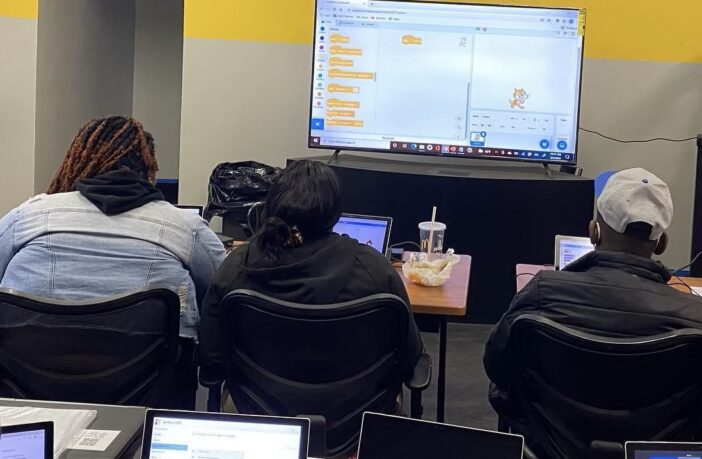Sandtown community members learn about coding at the Center for Technology Access and Training. The center was established by Michael Smith in 2013 to help bridge the digital divide. (Photo courtesy of Michael Smith)
By Megan Sayles
AFRO Business Writer
msayles@afro.com
Nearly three years ago, Michael Smith’s digital divide organization, the Center for Technology Access and Training (CETAT), received a grant from the Baltimore-based Abell Foundation to teach youth in Sandtown how to code.
The nonprofit decided to lean into game design to engage young people. The experience demonstrated the need for digital skills training and technology access in the neighborhood, which is predominantly Black. Since then, the center has relocated its headquarters to 1406 Laurens St., with a goal of delivering computer literacy training, coding education and troubleshooting services to residents in the community.
“If you look at the statistics in terms of some of the communities in Sandtown where we’re located, the rate of education, employment and access to high-speed internet is significantly lower,” said Smith. “We believe that technology can really be an equalizer for people in terms of being able to change their lives.”
According to the Baltimore Neighborhood Indicators Alliance, the median household income in Sandtown was $28,142 in 2022, with 54.2 percent of children living below the poverty line. The unemployment rate was 14.3 percent, more than three times the national average. Nearly 24 percent of residents aged 25 and older do not have a high school diploma or GED, and only 7 percent had a bachelor’s degree. Almost 40 percent of households had no internet.
The statistics reflect decades of disinvestment and historical discrimination in the West Baltimore community, which is more than 90 percent African American.
Smith, who studied computer science at Frostburg University, has been involved in technology for much of his career. He spent time working for a research hospital to gather statistics on autism and Huntington’s disease, and teamed up with nonprofits to usher them into the digital age.
It was his experience with the Greater Baltimore Urban League that led him to join the fight for digital equity. There, he helped establish community technology centers for Baltimore communities with scant accessibility after the organization received a grant from the Department of Education. Smith quickly realized that it was not just internet and devices that residents needed, but training.
“Initially, when people thought about the digital divide, they focused on having access to devices, then it broadened to the internet,” said Smith. “What we found over time is that it’s not just those two things, it’s also about having access to training to be able to use those things as well.”
He started CETAT back in 2013 and began by serving older adults in Prince George’s County. Bringing his work to Sandtown in 2021 was an opportunity to support community members with the least amount of access to technology and training.
Smith said digital literacy is now required for most careers, not just those in the technology sector. It has become something employers, educators and others consider a fundamental skill, much like how to read and write.
“We think about traditional literacy as a foundational skill for people. We believe the exact same thing in terms of technology literacy because it directly impacts people’s education, employment and access to information,” said Smith. “The same type of advocacy that people put forth for literacy should be put forth for technology literacy as well.”
Program Director Clifton Rogers was well-acquainted with barriers to technology and digital literacy. Growing up, he said he didn’t have a computer. Instead, he went to the library to send emails and access the internet.
“We just didn’t have the resources at the time,” said Rogers. “I always told myself, when I get in the position, I’m going to make sure that people have access to technology.”
Since moving to Sandtown, CETAT has collaborated with the local FutureCare, a rehabilitation and nursing facility, to teach older adults how to operate computers, cellphones and tablets. It has also hosted cyber security workshops to mitigate their vulnerability to attacks from scammers and phishers.
During the summer, the center runs the Create Initiative to teach young people about music and video production, photography, coding and drones. Youth who complete the program receive a certification in drone operation through a Federal Aviation Administration exam.
To enhance career skills, CETAT trains people in computer repair, Microsoft Office and web design. It also distributes refurbished computers to residents. Most recently, the center has ventured into hydroponics, a technique that allows people to grow plants indoors. It has a live vegetable wall and plans to teach students how to grow food in their homes.
CETAT’s next objective is to familiarize Sandtown residents with artificial intelligence (AI), as autonomous systems and machine learning continue to grow. Rogers believes that understanding the technology can prepare people for jobs of the future.
“Technology is everywhere, and people just use a small snippet of it. It’s in all of our lives, and yet so many people do not have access to it. This community in particular is hurting for that,” said Roger. “They want their minds to be turned on and to learn something that can be beneficial for their lives.”
This story is part of the Digital Equity Local Voices Fellowship lab. The lab initiative is made possible with support from Comcast NBC Universal.



